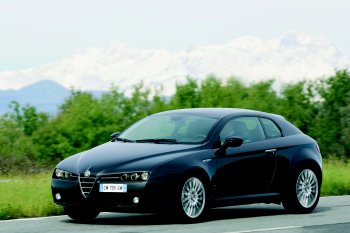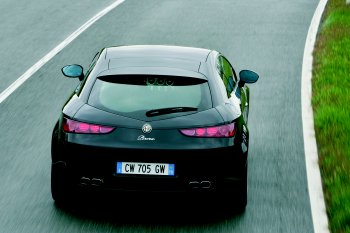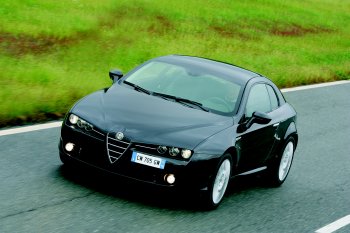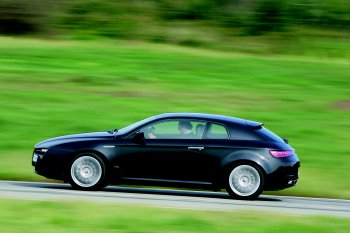|
SAFETY
AND DYNAMIC PERFORMANCE
|
|
Attractive
styling, great character and outstanding automotive
engineering: the Alfa Brera complements these distinctive
traits with other attributes and saves its best hand for the
fields of safety and dynamic performance. While driving
satisfaction has always been one of Alfa's
hallmarks, travelling satisfaction is a compulsory choice
when the car must assure outstanding comfort in addition to
Alfa character. The Alfa Brera therefore comes with high
double wishbone suspension and Multilink suspension systems.
This configuration ensures outstanding dynamic performance
and also excellent comfort. The person behind the steering
wheel can therefore make the most of the car's great
sporting performance without having to give up the high
standard of driving comfort afforded by the suspension. The
Alfa Brera also adds sporting attitude; the Q4 four wheel
drive system on the 3.2 V6 version - and the most advanced
electronic devices to control the vehicle's dynamic
behaviour (sophisticated VDC with non-intrusive sports
setting, complete with ASR and MSR). Not to mention,
naturally, the numerous devices and systems that help ensure
the highest standards of passive safety.
Roadholding: driving satisfaction and active safety
The new Alfa Brera is self-avowedly an Alfa in its
uncompromising sense of control and driving satisfaction.
Driving comfort and dynamic behaviour have always been
specific features of Alfa Romeo cars: on this car, they
amount to a real strength. First and foremost, the Alfa
Brera is fitted with suspension systems that are appealing
by any standards, the outcome of a new design that aims to
achieve results of maximum excellence: the front suspension
is high double wishbone type and the rear is multilink.
Hence a greater capacity to absorb road roughness; maximum
linearity and precision in the steering response - and great
roadholding, maximum stability in high-speed manoeuvres and
the agility of a true Alfa Romeo over tight mixed routes. In
detail, the products adopted and the benefits immediately
perceptible to customers are as follows:
Front suspension and steering
The new high wishbone layout adopted on the front suspension
is the ideal solution to guarantee precise control of wheel
movement, with a clearly defined steering axis. The
architecture was borrowed from racing and endows the car
with outstanding dynamic performance, and extremely
sensitive, pinpoint steering. The high double wishbone was
already used on the 159 and has been further improved on the
new Alfa Brera. First of all, the steering axis was brought
closer to the centre of the wheel, increasing the Ackerman
level (to increase parallel wheel movement when steering)
for better response when cornering, thanks to the steering
which is the most direct in its category. The steering of
the new Alfa Brera has an excellent ratio (12.7° steer for
every degree of wheel steer) for an overall rotation of 2
1/4 turns of the steering wheel, which translates into a
more direct response for the driver, more responsive
steering and better stability control.
What is more, painstaking analysis of the matching of the
steering geometry and the wheelarch volume, made it possible
to achieve high steering angles even with the largest tyres,
and this significantly improved the turning circle between
kerbs (10.7 metres). Great attention was paid to the new
wheel upright where it connects to the levers, exploiting
the available space inside the rims in full, and this has
significant advantages in terms of lateral rigidity; the
size of the coaxial damper spring unit with dual tube shock
absorber has been increased to improve its capacity to
absorb road roughness; the aluminium lower wishbone combines
excellent structural characteristics and a much lower
weight; the upper aluminium arm fits a pair of dry friction
sliding bushes, a solution chosen because it is stronger and
more reliable, and guarantees a more progressive action. And
finally, the suspension is connected to the chassis by a
closed geometry frame which is stiffer than the previous
solution which had a simple crossbeam.
Rear suspension
The new Multilink rear suspension allows wheel movement to
be controlled in a sophisticated manner, achieving the best
possible balance in terms of performance. The system with
three levers and a transverse blade highlights the
performance of the various components subject to
longitudinal load, to improve the filtering of roughness
and, under a lateral load, achieving faster responses,
enhanced stability and extreme grip.
The rear suspension of the Alfa Brera now features:
-
A higher
anchorage point for the longitudinal link, which is now
positioned higher than the centre of the wheel, allowing
the suspension to perform a longer, more flexible
stroke, with an optimal response when negotiating an
obstacle.
-
The
aluminium upright, fitted with a third generation,
extremely rigid hub, supports the connection bushes for
the camber lever and the longitudinal link.
-
The bi-tube
spring-damper unit is larger than other conventional
solutions, this achieves a better compromise between
handling and comfort.
-
The camber
link, which allows the static camber to be adjusted and
produces a geometry capable of guaranteeing a good
camber recovery with wheel shake to ensure that the
wheel rests perfectly on the road and wear is thus
uniform, even when the car is pushed to the limit.
-
The rear
hydraulic bush guarantees excellent filtering of
roughness, and allows the wheel to retract slightly when
negotiating an obstacle.
-
A high
tensile steel crossbeam isolated from the bodyshell by
four elastic bushes that dampen high frequency
vibration.
The Alfa Romeo Q4 4-wheel drive
system
The new Alfa Brera with the powerful 3.2 JTS offers the same
4x4 system with three differentials already adopted on the
Alfa 159 Q4. This takes the form of the ultra-new Twin Diff
system that represents the latest development of the Torsen
C. The Brera's central differential is a Torsen C that
encloses the front differential for the first time, a
solution that ensures considerable benefits in terms of
dimensions, weights and also performance. It exploits the
forces set up by the front differential to increase its
locking effect (35% during traction and 45% during release)
to set up a self-locking effect on the front differential as
well (up to 20%). The consequence of this is improved
traction and cornering stability.
The basic torque distribution of the Q4 system is mainly to
the rear (43/57) for greater sportiness. Due to its locking
effect, the central differential is able to send drive
torque to the axle with the best grip on the ground moment
by moment. This allows the system to switch from the initial
torque distribution pattern to a distribution pattern
focused on the front (72/28) or a distribution focused on
the rear (22/78) in fast, automatic and continuous manner
according to the grip and slip levels of all four wheels.
The Alfa Romeo Q4 four wheel drive system implements
permanent, dynamic torque distribution over all four wheels
to achieve the highest levels of active safety and
sportiness. The Alfa Brera Q4 is four wheel drive Alfa Romeo
style: an essentially mechanical system complemented by the
most advanced electronics to assure maximum driving comfort
together with optimum performance and total safety.
The vehicle is absolutely cutting edge as far as engineering
is concerned and offers significant benefits:
-
The Q4's
four wheel drive with advanced Torsen C self-locking
differential (Twin Diff.) makes it possible to achieve
improved roadholding, driving satisfaction and smooth
responses.
-
Preferential
distribution to the rear axle also adds to driving
satisfaction because it makes the car easier to handle
while ensuring maximum stability when the car suddenly
veers at top speed on the motorway, as can happen during
emergency manoeuvres.
-
The ability
to travel safely in poor grip conditions without the aid
of electronics in torque split for constant driving
satisfaction.
Tyres and pressure sensor
The excellent on-road behaviour of the Alfa Brera is also
aided by its tyres that achieve the best possible compromise
between handling and comfort. To guarantee a controlled
drift on corners, combined with an excellent capacity to
absorb obstacles, the Alfa Romeo engineers and their
suppliers have developed special larger tyres, up to 235/45
R 18. In addition, from 2006, the Alfa Brera will also
feature a tyre pressure sensor that signals any anomalies by
a buzzer and a message on the display.
Braking system
The system is the most competitive in its class and upholds
Alfa Romeo tradition in this field. The power-assisted,
hydraulic system comprises two cross-over independent
circuits, and is particularly effective, guaranteeing
prompt, smooth braking combined with minimal stopping
distances.
|

 |
|

 |
|
The system naturally differs according to the engine version
(in terms of weight and power): vehicles equipped with the
2.2 JTS are fitted with 305 mm
self-ventilated discs on the front wheels and cast iron
floating calliper with piston; the rear brake discs are
solid (278 mm diameter) while the calliper is aluminium with
a piston.
The powerful Alfa Brera 3.2 JTS Q4 is fitted with 330 mm
ventilated discs with a four piston monobloc aluminium
calliper on the front wheels; a 292 mm disc, also
ventilated, with a floating calliper on the rear wheels.
This vehicle marks the first application of a monobloc
aluminium calliper with radial attachments to the front
brakes of an Alfa Romeo: this option increases calliper
stiffness without increasing the weight and therefore makes
for increased performance, particularly during a sporty
drive.
ABS with EBD
In addition to a high-performing brake system, the Alfa
Brera also comes with one of the most advanced ABS antilock
brake systems on the market today. It features four active
sensors and a hydraulic control unit with 12 solenoids. The
ABS contains an electronic brakeforce distributor (EBD).
This device apportions braking action over all four wheels
to prevent locking and ensure full control of the car under
all conditions. The system also adapts its operation to
wheel grip conditions and brake pad efficiency to reduce pad
overheating.
VDC (Vehicle Dynamic Control)
The VDC is Alfa Romeo's version of the ESP (Electronic
Stability Program), a system that cuts in under extreme
conditions when car stability is at risk and also helps the
driver to control the car. As befits a true Alfa, the VDC is
a sporting device that makes for outstanding roadholding. It
allows the driver the full satisfaction of controlling the
car as long as conditions are normal but cuts in just before
things become critical. The VDC is permanently engaged.
The MSR (Motor Schleppmoment Regelung) cuts in when the gear
is shifted down abruptly under conditions of low grip. This
device restores torque to the engine to prevent the wheel
skidding as a result of lock. To achieve this result, the
VDC continually monitors tyre grip in both longitudinal and
lateral directions. If the car skids, it cuts in to restore
directionality and ride stability. It uses sensors to detect
rotation of the car body about its vertical axis (yaw
speed), car lateral acceleration and the steering wheel
angle set by the driver (which indicates the chosen
direction). It then goes on to compare these gathered data with
parameters generated by a computer and establishes - via a
complex mathematical model - whether the car is cornering
within its grip limits or if the front or rear is about to
skid (understeer or oversteer).
To restore the correct trajectory, it then generates a
yawing movement in the opposite direction to the movement
that gave rise to the instability by braking the appropriate
wheel (interior or exterior) individually and reducing
engine power (via the throttle). This is the key attribute
of the device designed by Alfa Romeo engineers. It acts in a
modulated fashion on the brakes to ensure the action is as
smooth as possible (and the drive is not therefore
disturbed). The engine power reduction is contained to
ensure outstanding performance and great driving
satisfaction at all times. As it carries out its complex
task, the VDC stays in constant communication with the brake
sensors and engine control unit but also with:
-
a body
computer that constantly exchanges information with the
ABS, engine management unit and automatic transmission
unit;
-
an
electronic throttle (that communicates with the ABS in
turn);
-
a control
panel (active warning lights);
-
the steering
wheel and steering column (via the steering sensor);
-
a gyroscopic
sensor installed on the passenger compartment floor to
record car yaw and lateral acceleration.
ASR (Anti Slip Regulation)
The ASR (Anti Slip Regulation) system, an integral part of
the VDC, optimises traction at any speed with the aid of the
brakes and engine control. The device computes degree of
slip on the basis of wheel rpm calculated by the ABS sensors
and activates two different control systems to restore grip:
when an excessive power demand causes both drive wheels to
slip (e.g. in the case of aquaplaning or when accelerating
over an unsurfaced, snowy or icy road), it reduces engine
torque by reducing the throttle opening angle and thus air
flow; if only one wheel slips (e.g. the inside wheel
following acceleration or dynamic load changes), this is
automatically braked without the driver touching the brake
pedal. The resulting effect is similar to that of a
self-locking differential. This allows the Alfa Brera to get
out of trouble easily on road surfaces with low grip. The
ASR is activated automatically whenever the engine is
started but must be turned off by means of a cut-out switch
on the central console. The ASR only needs to be turned off
when snow chains are used because the wheel must be able to
slip by tiny amounts to pile up the snow so that force can
be transmitted to the ground and the ASR tends to prevent
this occurring.
HBA and Hill-holder
The equipment array on the Alfa Brera is completed by the
HBA system, the hydraulic electronic braking assistant which
automatically increases the pressure in the braking circuit
during emergency braking. And by the Hill-holder system,
which maintains braking pressure for a few moments after the
driver removes his foot from the pedal, to simplify hill
starts and prevent the car from slipping backwards.
Cutting-edge systems for total protection
Passive safety also benefits from state-of-the-art
technology. And goes on to include a new chassis designed to
absorb impact with maximum efficacy. Occupants are also
protected by the body and doors, without forgetting the
Isofix attachments for carrying the tiniest occupants with
maximum safety. The car also offers innovative restraint
systems (pretensioner on the buckle and a degressive load
limiter on the seat-belt) and numerous airbags (at least
seven as standard): front with two-stage activation,
sidebags and curtain-bags to protect the rear seats as well,
and new devices that safeguard the driver's knees. These
kneebags (the passenger bag is an option) prevent contact
with the dashboard surface and help achieve the highest
safety levels.
They are complemented by two front airbags with two-stage
activation: for the driver (with capacity of 60 litres) and
passenger (120 litres). Their operation is controlled by an
electronic control unit on the tunnel that evaluates impact
severity by means of sensors that are calibrated by
conducting crash tests in the laboratory. The system comes
with a diagnostic circuit for checking components
electronically. The components are tested by a processor
that monitors their operation continuously. The airbags will
not be activated by low speed accidents (for example, a
slight shunt or a bump while parking) or by stresses that
are not due to impact (e.g. driving fast over a pothole). On
certain markets, the car is fitted with a front passenger
airbag that may be deactivated manually so that a baby can
be carried in a seat with its back to the direction of
motion (the pretensioner remains active).
The Alfa Brera is fitted with two sidebags to protect the
pelvis and chest of front seat passengers when the car is
struck from the side. They are located inside the front seat
squabs. This solution ensures the best possible protection
for passengers regardless of their stature, sitting position
or seat setting. For geometrical reasons, it is also
possible to use a 12 litre airbag: this volume is lower than
an airbag housed in the door would require to offer the same
protection. The sensors controlling activation of these
airbags are located in the central pillars. If an accident
occurs, they receive a side acceleration signal and send it
to the electronic control unit that is also responsible for
operating the front airbags and seat-belt pretensioners. All
systems are managed in an integrated manner in accordance
with a strategy of total, progressive occupant safety.
The Alfa Brera is also fitted with curtain-bags that drop
down along the windows to safeguard the passengers' heads in
the case of side impact. The curtain-bags adopted on the new
model are more protective than other products, faster to
inflate and less invasive for passengers. They open from top
to bottom and do not involve a risk of secondary damage to
occupants' arms. They also effectively safeguard the heads
of front and rear passengers because they extend along the
entire width of the window and ensure protection even during
rollover. Two bags (one on the right and the other on the
left) are located under the roof rails where they are folded
into a closed compartment. At the appropriate moment, the
covering bends open to allow the bags to expand and drop
downward. Lastly, the new model is fitted with a mechanism
to release the pedals in the event of frontal impact to
protect the lower limbs.
|
|